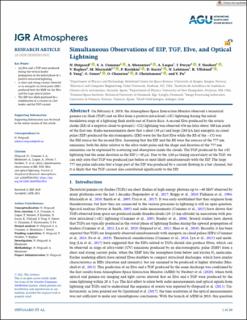Simultaneous Observations of EIP, TGF, Elve, and Optical Lightning
Østgaard, Nikolai; Cummer, S.A.; Mezentsev, Andrey; Luque, Alejandro; Dwyer, J.; Neubert, Torsten; Reglero, Victor; Marisaldi, Martino; Kochkin, Pavlo; Sarria, David Alexandre Stephan; Lehtinen, Nikolai Grigorievich; Ullaland, Kjetil; Yang, Shiming; Genov, Georgi; Chanrion, Olivier; Christiansen, Freddy; Pu, Y.
Journal article, Peer reviewed
Published version

Åpne
Permanent lenke
https://hdl.handle.net/11250/2985601Utgivelsesdato
2021Metadata
Vis full innførselSamlinger
Originalversjon
Journal of Geophysical Research: Atmospheres. 2021, 126 (11), e2020JD033921. 10.1029/2020JD033921Sammendrag
On February 8, 2019, the Atmosphere-Space Interaction Monitor observed a terrestrial gamma-ray flash (TGF) and an Elve from a positive intracloud (+IC) lightning during the initial breakdown stage of a lightning flash north east of Puerto Rico. A second Elve produced by the return stroke (RS) of a negative cloud-to-ground (−CG) lightning was observed 456 ms later about 300 km south of the first one. Radio measurements show that a short (30 μs) and large (280 kA km) energetic in-cloud pulse (EIP) produced the electromagnetic (EM) wave for the first Elve while the RS of the −CG was the EM source for the second Elve. Assuming that the EIP and the RS were the sources of the 777 nm emissions, both the delay relative to the ultra-violet pulse and the shape and duration of the 777 nm emissions can be explained by scattering and absorption inside the clouds. The TGF produced by the +IC lightning had the same duration as the EIP (∼30 μs). Due to the ±80 μs timing uncertainty of the TGF, we can only state that TGF was produced just before or most likely simultaneously with the EIP. The large 777 nm pulse indicates that a large part of the EIP was produced by a current flowing in a hot channel, but it is likely that the TGF current also contributed significantly to the EIP.
